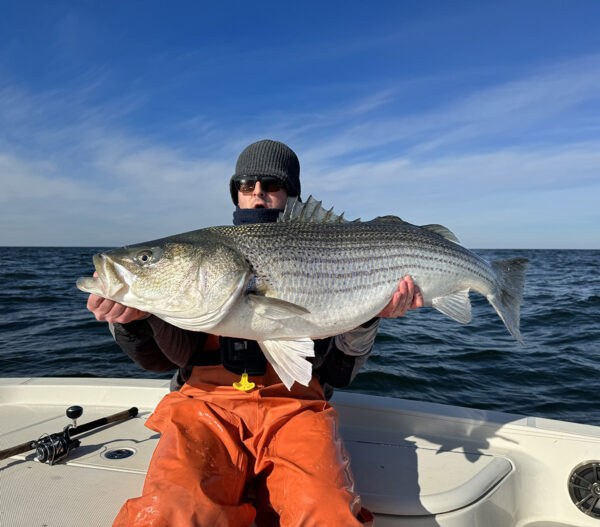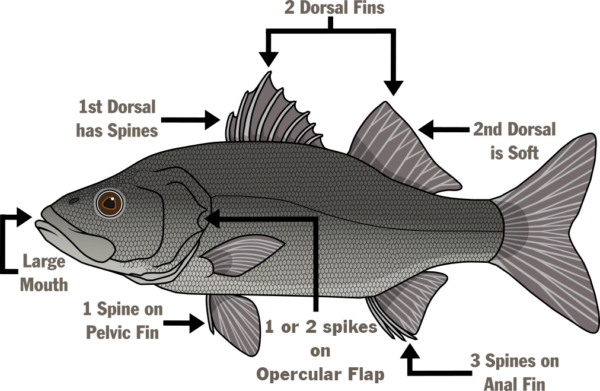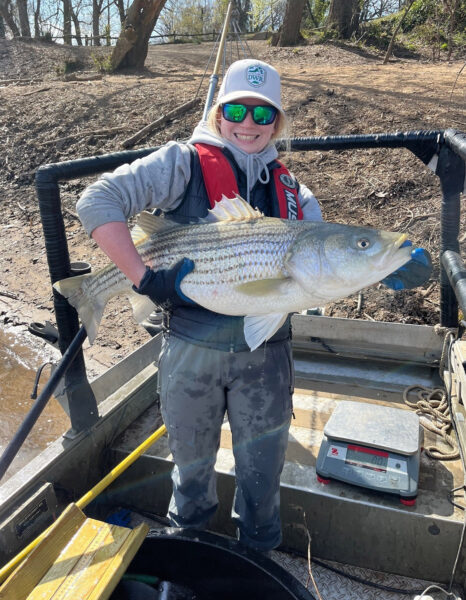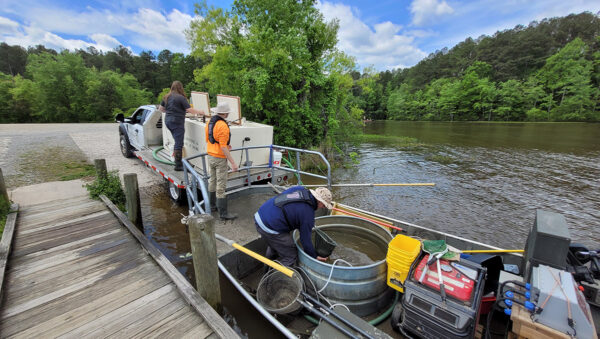DWR Fish Passage Biologists perform efficacy monitoring at project sites throughout Virginia. Pictured is Assistant Fish Passage Biologist Matthias Gaffney holding a large migratory Striped Bass. ©Photo by Alan Weaver
An angler releases a Striped Bass back to the water. ©Photo by Scott Herrmann
Fact File
Scientific Name: Morone saxatilis
Classification: Fish, Order Moroniformes, Family Moronidae
Size: Striped Bass in Virginia can grow beyond 5 feet in length within the lower reaches of our tidal rivers; 36 to 40 inch Striped Bass can be found under ideal conditions throughout the rest of the state
Life Span: Striped Bass in Virginia can live up to 30 years. The average lifespan is much lower, and specific to each waterbody
Identifying Characteristics

A large Striped Bass caught in Virginia’s Chesapeake Bay. ©Photo by Alex Mccrickard
- Streamlined, elongate body with several prominent black horizontal stripes that extend from the gill plate to the tail
- Coloration shades from dark olive above through silvery sides to a white belly
- A silvery iridescent shine with light purple to bluish hues may be present along the fins, back and sides of some individuals
- A series of spines give way to soft rays on the dorsal fin
- Spines are present on the gill cover
- Two distinct patches of teeth are present on the tongue
Diet
Striped Bass are a highly predatory species. Juvenile fish consume larval fish, insect larvae, and small crustaceans. As they mature, they become increasingly piscivorous (fish eating) as adults. Within the Chesapeake Bay, Striped Bass feed on a variety of smaller fish such as Menhaden, Blueback Herring, Alewife, and American Eel. Reservoir populations of Striped Bass are forced to be more opportunistic, and will feed on the forage that is available in that particular body of water. Generally, these fish will feed heavily on Gizzard Shad or Threadfin Shad, as well as landlocked Alewife and Blueback Herring where available.
Distribution:
In Virginia, Striped Bass are native to tributaries of the Albemarle Sound, Chesapeake Bay and the Atlantic Ocean. They have been introduced into reservoirs throughout much of the state.

Moronidae Characteristics and Anatomical Terms


Illustrations by ©Makayla Haggard – DWR
Habitat
Physical Habitat
The Striped Bass is an anadromous species of fish, which means it spends most of its adult life in saltwater environments, but returns to freshwater tributaries in order to fulfill its reproductive cycle. Within Virginia, the Department of Wildlife Resources has also successfully established Striped Bass fisheries in many of the state’s freshwater reservoirs. Due to their ubiquitous presence within the Commonwealth, they can be found occupying a variety of different habitats throughout Virginia, but can often be found in schools along channel gradients, sandy flats, and underwater grass beds. Some individuals prefer to reside close to hard structures such as oyster reefs or rocky shorelines and jetties. Their affinity for rocky habitat has given them the nickname of “rockfish” with anglers throughout the coastal region.
Water Quality
Striped Bass thrive in cooler, highly oxygenated waters. During periods of extreme heat and drought, reservoir populations of Striped Bass will often congregate in deeper water just above the thermocline. It is in this zone where they must orient themselves deep enough for cooler water, but not at such depths where dissolved oxygen is completely absent.
Reproduction and Life History
Anadromous Striped Bass
Each spring, anadromous species of fish such as Striped Bass migrate from the Atlantic Ocean to spawn in the freshwater reaches of Virginia’s tidal rivers. This migration is triggered by increasing daylight, rising water temperatures, and increased stream flow.
Striped Bass actively spawn once water temperatures begin to reach about 55°F. As schooling broadcast spawners, the process occurs near the water’s surface. Once a female Striped Bass has selected an adequate spawning area, she will release hundreds of thousands to millions of semi-buoyant eggs into the water column. Simultaneously, there will be numerous males that release milt (fish sperm) that fertilizes the eggs as they disperse. The fertilized eggs will then drift with the currents for 2+ days until they hatch out, producing a larval fish, which is termed fry. After hatching, larval Striped Bass feed on their self-contained yolk-sac.
After about 2 weeks the yolk-sac will be fully absorbed, and the fish will transition to feeding on zooplankton present in the water column. Surviving individuals will spend years in Virginia’s estuaries. Once juvenile Striped Bass become reproductively mature (between 2 and 6 years old), they emigrate to saltwater and join the migratory stock.
Inland Striped Bass
Striped Bass found in Virginia’s larger reservoirs often migrate up the tributary rivers, mimicking their instinctual spawning process. However, spawning is almost entirely unsuccessful. Virginia’s Staunton River is one of the few examples of landlocked Striped Bass successfully reproducing. Landlocked fisheries of Striped Bass only maintain populations sustainable for angling due to Virginia DWR’s stocking program.
Striped Bass Management in Virginia
Virginia Department of Wildlife Resources
Inland populations of Striped Bass in Virginia are managed by the Virginia Department of Wildlife Resources. Bag limits, size limits, and slot limits vary by waterbody and are based on habitat availability, forage availability, and other variables.
DWR Striped Bass & Hybrid Striped Bass Management Plan
Virginia Marine Resources Commission
Striped Bass found within Virginia’s tidal tributaries, the Chesapeake Bay, and along the Atlantic Coast are managed by the Virginia Marine Resources Commission (VMRC). The Department of Wildlife Resources would like to remind anglers to familiarize themselves with VMRC regulations prior to recreating in these areas.
Threats to Striped Bass in Virginia
- Angler-related mortality
- Increasing water temperatures associated with climate change
- Predation from non-native species
- Sedimentation due to poor land-use practices and/or development
- Water quality impairment
Additional Striped Bass Information
Kerr Lake Striped Bass Sampling
Conserving Virginia’s Striped Bass – The Science of Catch and Release
Hatching and Raising Striped Bass in Virginia
Winter Fishing for Striped Bass on Virginia’s Lake Anna
Last updated: November 6, 2024
The Virginia Department of Wildlife Resources Species Profile Database serves as a repository of information for Virginia’s fish and wildlife species. The database is managed and curated by the Wildlife Information and Environmental Services (WIES) program. Species profile data, distribution information, and photography is generated by the Virginia Department of Wildlife Resources, State and Federal agencies, Collection Permittees, and other trusted partners. This product is not suitable for legal, engineering, or surveying use. The Virginia Department of Wildlife Resources does not accept responsibility for any missing data, inaccuracies, or other errors which may exist. In accordance with the terms of service for this product, you agree to this disclaimer.



